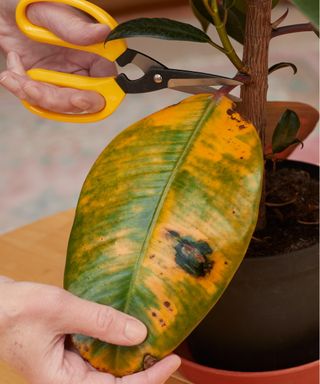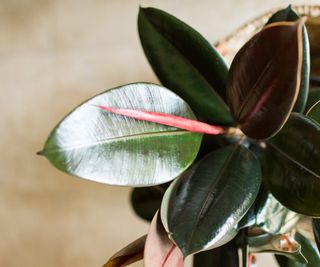Just recently, I finally got one of my dream houseplants: a variegated rubber tree. This hardy indoor plant can adapt to almost any spot in your home. Personally, I love the variegated variety for its cream color and pattern. The only problem was that the plant I got had a few discolored leaves at the base that needed some care.
If you have a rubber tree, or Ficus Elastica, you know that its showy leaves make a statement in any room. So it can be worrying to see your rubber tree drooping or turning brown. The thought of having to use pruning shears on such a beautiful plant is even more daunting, but I quickly learned that giving my rubber tree the pruning it needs is exactly what it takes. In fact, you can prune your rubber tree to encourage it to grow more lushly, even if it doesn't have any unhealthy leaves to begin with.
Just like pruning plants in your garden, there's an art to pruning houseplants properly. But don't worry, this tricky task is actually quite easy. We'll tell you everything you need to know about how to prune a rubber tree, including expert advice, so you can get them looking their best.
(Image credit: Firdausiah Mamat via Getty Images)
Two ways to prune a rubber tree
Depending on your goals, there are a few different ways to prune a rubber tree. One of the biggest mistakes in pruning is not knowing how or when to prune your plant. No matter which method you use to prune your rubber tree, if you don't prune it correctly, it can cause problems with future growth. But look no further. Here are two different ways to prune a rubber tree and some expert tips to help you do it successfully.
How to prune a rubber tree with damaged leaves

(Image source: lucentius via Getty Images)
The first reason why you need to prune a rubber plant is because it has dead or damaged leaves, like my rubber plant did. If you don't remove these leaves, it can be harmful because the plant will direct its energy towards the unhealthy leaves instead of new growth.
“Pruning helps remove dead leaves, keeping your rubber trees looking nice and reducing the risk of pests and disease,” points out Paris Larricata, plant education and community manager at The Sill.
Luckily, when it comes to pruning rubber trees in this way, any time is a good time to do so: “If you're pruning dead or sagging leaves from your plant, you can do so whenever necessary,” Paris points out.
To accomplish this task, you'll need some essential gardening tools. Personally, I like to use gardening scissors, which I purchased from Amazon, when trimming my houseplants. They're small and easy to use, allowing you to make precise cuts. “Pruning shears with fine tips can be used to prune dead leaves and new growth at the tops while they're still tender,” suggests Paris.
To prune unwanted leaves, simply use scissors to cut the base of the stem (also called the petiole) where it is attached to the trunk of your rubber plant. This will make your rubber plant look healthier in no time.
“Prune slowly and carefully to avoid over-pruning and ruining the look of your plant,” advises Julie Borden-Davis, indoor plant expert at Healthy Houseplants. “Also, don't prune more than a third of the plant in one go, as this can shock the plant,” she adds.

Social Links Navigation
Indoor plant specialist
Paris has been with The Sill for five years and is responsible for plant education and community. She is a self-taught plant expert with over 10 years of houseplant growing experience and is currently working towards becoming a certified sustainable gardener. She maintains an indoor garden with over 200 plants in the Northeast US and is passionate about making plant care more accessible to budding plant parents.

Social Links Navigation
Indoor plant specialist
Julie Borden Davis is a horticultural author, a University of California Certified Master Gardener, and the author of several gardening books, including “Indoor Gardening The Organic Way.” She runs HealthyHouseplants.com and shares indoor gardening advice on her YouTube channel, @HealthyHouseplants.
How to prune rubber trees to encourage branch growth

(Image credit: Getty Images/Crystal Bolin Photography)
The second reason to prune a rubber tree is to encourage bushier growth. When a rubber tree first takes root, it forms a single trunk from which leaves grow, which is why many people call it a rubber tree. However, if you want branches to grow on the trunk of your tree, there are certain ways to prune your rubber tree.
“You want to make the cut at an internode, which is the space between two nodes (or leaves),” Paris says. “This will encourage the trunk to develop two lateral buds and the tree to branch out, as long as the plant is receiving optimal care,” she adds.
Smaller pruning shears used to remove damaged leaves may not be suitable for this type of pruning. “If you're pruning the woody parts of your rubber tree, you may want to use pruning shears with larger blades,” suggests Paris. Try these pruning shears from Amazon.
The best times to prune your rubber plant for branch growth are in the spring and summer. “These are the times when the plant is actively growing,” says Paris. If you're propagating your rubber plant from cuttings, make sure you prune in the spring and summer when growth is most active.
After pruning, your rubber plant will need some extra care. This includes providing it with plenty of indirect light, maintaining consistent moisture levels, and even fertilizing it. You can also fertilize your rubber plant with this all-purpose houseplant fertilizer from Amazon, but only do this when the plant is actively growing. Be sure to also clean your gardening tools after use to prevent pests and diseases from being transmitted between plants.
FAQ
What is that sticky sap on rubber trees?
The rubber tree, or Ficus elastica, is beloved for its bold leaves. But when you prune your rubber tree, you may notice a sticky white sap coming out of the leaves.
“Rubber trees contain latex sap, which can be irritating to people with sensitive skin or latex allergies,” says Paris Larricata, plant education and community manager at The Sill.
You can take precautions by wearing gardening gloves, which you can buy at Walmart, when pruning rubber trees.
I am so happy to finally add a rubber plant to my collection, and even happier that I pruned the damaged leaves. It has been growing well ever since. It may seem like a lot of work, but don't be afraid to prune your rubber plant as needed to encourage healthier growth.
If you want to have more rubber plants in your home but don't have enough floor space for larger plants, you can choose a miniature rubber plant that is suitable for placing on a windowsill.


